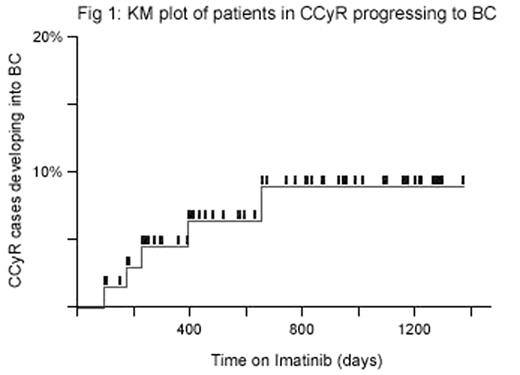Abstract
Stem cell transplantation (SCT) remains the only proven curative therapy for chronic myeloid leukemia (CML) but is limited by significant procedure related morbidity. Imatinib is the first of a new generation of specifically targeted drugs for this disorder based on the ubiquitous presence of the BCR-ABL kinase. The success of Imatinib therapy to induce a cytogenetic remission (CCyR) raises questions over the suitability and timing of SCT as a treatment for CML. Of importance is the degree of protection CCyR infers from developing a blast crisis. We report a total of 68 patients from five centres all of whom started Imatinib within six months of diagnosis of 1st chronic phase CML and subsequently achieved a complete cytogenetic remission. In this group, five cases spontaneously developed blast crisis despite achieving a CCyR. In the affected patients CCyR was achieved between 97 and 254 days (mean 148 days) and BC developed between 177 and 875 days (mean 446 days). The BC was myeloid in three cases and lymphoid in the remaining two. Statistical analysis of this group predicts a 91% freedom from blast crisis at two years (figure 1). The development of acute leukemia is assumed to derive from further mutations within the BCR-ABL expressing stem cell pool. The success of SCT therapy in curing CML drops significantly if the patient has previously progressed to a blast crisis. The finding that cytogenetic remission is no guarantee of protection from developing a blast crisis suggests that for young patients with a sibling match, stem cell transplantation may be considered as an early therapy in the management of CML.
Author notes
Corresponding author


